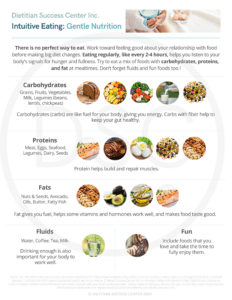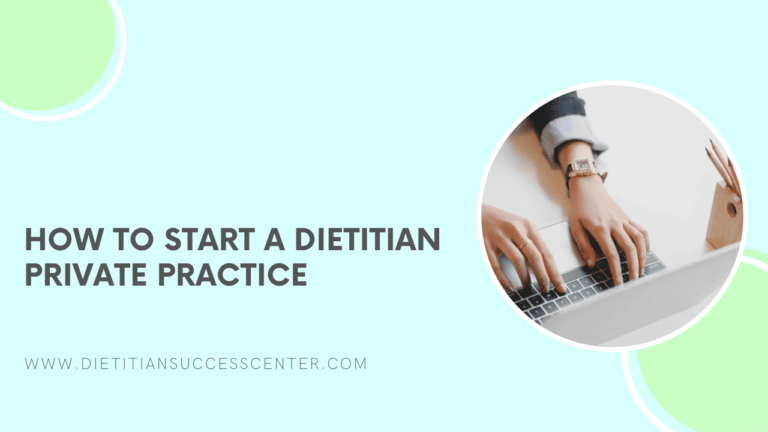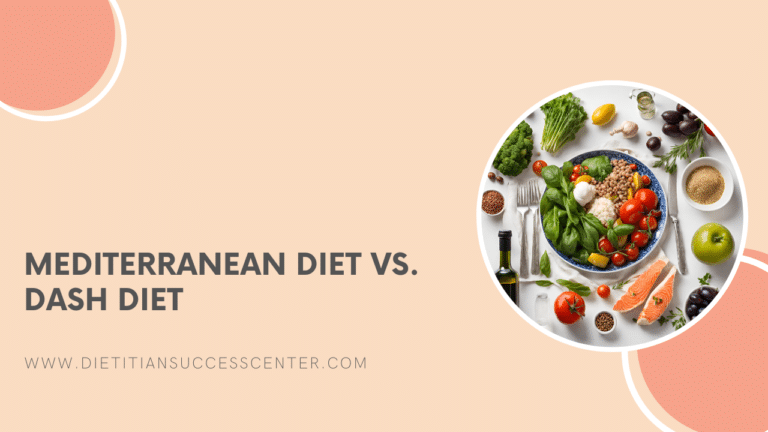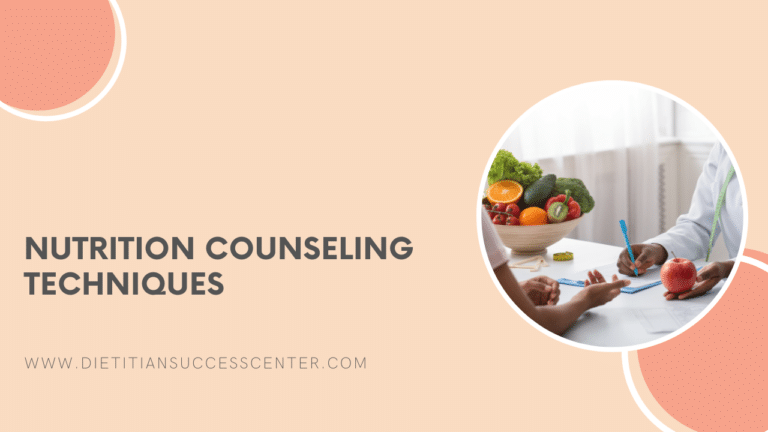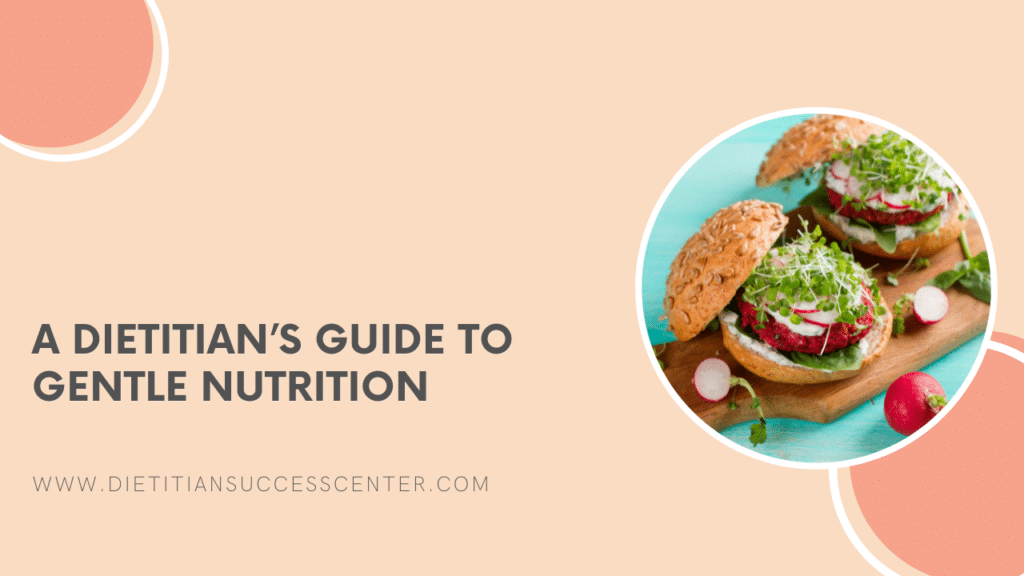
Written by Oleska Prokopovych (dietetic intern)
Reviewed by Krista Kolodziejzyk, RD, MPH, MBA and Olivia Farrow, RD, MHSc
Gentle Nutrition is the tenth and last principle of Intuitive Eating.
In this article, we share what it means to practice Gentle Nutrition based on information from these books written by Evelyn Tribole and Elyse Resch:
“Intuitive Eating is not about perfection—it’s simply about offering you guidelines for a comfortable relationship with food.” (1)
Where Intuitive Eating Meets Nutrition
As described by the authors Evelyn Tribole and Elyse Resch, Intuitive Eating incorporates our instincts, emotions, and thoughts into our eating patterns (1).
We learn to trust our instincts through the practice of honoring our hunger and fullness cues (e.g. eating when hungry and stopping when full).
We are aware of the emotions we feel or do not feel towards food (e.g. feeling guilt or shame around eating certain foods).
And lastly, we are thoughtful about our eating behaviors and food choices (e.g. planning a meal ahead of time to avoid intense cravings and excessive snacking)
With intention, we can make food choices that support our health and also align with our personal values (1,2). If you are unfamiliar with the ten principles of Intuitive Eating or would like a refresher, check out our blog post Intuitive Eating Guide for Dietitians where we give an overview of the concept. To learn even more, become a member of the Dietitian Success Center to access DSC’s Intuitive Eating toolkit and video course.
What is Gentle Nutrition?
Gentle Nutrition takes everything you have learned about the first nine principles of Intuitive Eating and applies it in choosing what to eat. It teaches us how to eat nutritiously while remaining emotionally neutral towards all foods in a way that aligns with our values (1,2). In order to truly feel neutral towards all foods, the previous principles of Intuitive Eating must be well understood and accepted (1,2).
Gentle Nutrition is the compromise between your inner world of hunger signals and cravings, and the outer world of health information, spiritual beliefs, and ethical values toward food (1,2). It is choosing what you want to eat based on more than what tastes good. It is the opposite of dieting and eating guided by strict rules. Instead, it is about eating nutritious foods in a way that is satisfying to you (1,2).
Gentle Nutrition can look like…
-
- Finding ways to eat more fruits (e.g. adding fruit to a smoothie when you don’t enjoy eating whole fruits)
-
- Avoiding gluten for someone with celiac disease
-
- Trying a new vegetable every week to eat more variety of foods
-
- Following a Kosher diet to adhere to Jewish tradition
-
- Reducing foods that cause you physical discomfort (e.g. broccoli, spicy food, etc.)
-
- Switching from white bread to whole-grain bread
-
- Minimizing dark chocolate consumption at night to prevent caffeine-related sleep issues
-
- Trying new recipes to discover nutritious meals that you truly enjoy
-
- Avoiding alcohol to support a healthy pregnancy
-
- Adding chopped vegetables to a frozen pizza
Factors that Influence Our Food Choices
When deciding on what to eat, there are many factors involved, not just cravings and hunger. Here are some examples of factors that may affect your decisions about food (1,2):
-
- Religious or cultural beliefs (e.g. avoiding alcohol, avoiding pork, etc.)
-
- Distance from a grocery store
-
- Money available to spend on food and food prices
-
- Changes in appetite due to stress, sickness or medications
-
- The appearance or texture of a food item
-
- The practicality of the food item (e.g. it doesn’t get stuck in your teeth)
-
- The convenience of a food item (e.g. requires little to no cooking or preparation)
-
- The physical effect of the food item (e.g. food that doesn’t upset your stomach)
-
- The sustainability and ethics of the food item (e.g. avoiding animal products, shopping at farmers markets, etc.)
Overcoming Common Barriers to Achieving Gentle Nutrition
There are some barriers that prevent clients from successfully practicing Gentle Nutrition. These barriers include (1,2):
-
- A lingering diet mentality (previous dieting patterns or a history of dieting)
-
- An obsession with nutrition (being overly focused on healthy eating and believing that certain foods should never be eaten)
-
- Nutrition misinformation (not knowing what to believe with so many available sources of nutrition information)
A Lingering Diet Mentality
Many people are unable to see foods neutrally due to the presence of a diet mentality (1,2). Diets teach us to follow rules that are disconnected from our bodies’ signals. This includes information on when, how much, and what to eat. For example, the intermittent fasting diet tells you when to eat, calorie restrictive diets tell you how much to eat, and food-specific diets (e.g. the ketogenic diet) tell you what to eat. Usually, foods that are “not allowed” in diets are painted in a bad light, causing people to have negative associations to those foods (1,2). Unfortunately, a diet mentality can cause someone to see Gentle Nutrition as a new type of diet if they haven’t first worked through the other steps of Intuitive Eating (1,2).
Tips for Dietitians
It is very important to identify if a client is ready to take Intuitive Eating to the final step of Gentle Nutrition. Here are several points to consider (2):
-
- If the client has a medical condition that could benefit from nutrition
-
- If the client feels emotionally neutral towards all foods
-
- If the client is able to enjoy a food with lower nutritional value without feeling guilt.
-
- If the client is able to enjoy the pleasure food brings AND consider how they will feel physically after eating. For example, a food could cause an upset stomach, excessive gas, feeling lethargic, feeling energized, etc.
It can also be helpful to discuss the language used around food. Tribole and Resch recommend using more neutral language for processed foods. They use the term “play foods” instead of junk food (1,2). Although processed foods are lower in nutritional value, they still offer pleasure and should not be demonized. It may also help to share the Intuitive Eating Bill of Rights to remind your client to give themselves permission to eat.
An Obsession with Nutrition
Tribole and Resch coined the term “nutritionism” to mean an overfocus on the physical health and wellness results that food provides and an underfocus on the psychological results (2). For example, people can become obsessed with eating healthfully to the point of disordered eating, referred to as orthorexia (2). Focusing on the nutritious elements of food can backfire for someone who is still new to Intuitive Eating.
Tips for Dietitians
Some clients may fear any change to their diet will lead directly to disease, weight gain, or other perceived negative consequences in the near or distant future. It can be helpful to demonstrate that food does not always have a negative impact on one’s health. Examples of scenarios where people are healthy despite their “unhealthy” diet include the following (2):
The French Paradox
Although the French eat a diet high in cholesterol and saturated fat, they have much lower rates of heart disease compared to Americans. The French also have a longer life expectancy, they diet less, and they eat less low-fat and diet food products than Americans.
Micheal Phelps
This Olympic gold medalist regularly ate a diet high in cholesterol, saturated fat, processed meat, and refined grains. Despite this, he is the most successful Olympian of all time.
The Roseto Effect
A small Italian immigrant community in Roseto, Pennsylvania took up a westernized diet. For three generations, this community showed impressively low rates of death from heart attack and incidence of heart disease. The community’s strong social environment is what sets this group apart.
Nutrition Misinformation
It can also be very confusing for the average person to obtain the most accurate information about nutrition (2). There are endless sources of nutrition guidance through the media and the internet. Much of this information directly contradicts other information on the same topic. This is partially due to the ever-evolving nature of research (2). As new studies emerge with unique perspectives, news articles and the media are quick to dramatize the facts. One source could say dairy foods cause inflammation and another could claim dairy has anti-inflammatory properties. This can leave many individuals questioning which sources they can trust and why the information is so inconsistent.
Tips for Dietitians
To avoid confusion, you can teach clients where to find reliable nutrition information, and how to discern whether a piece of content is evidence-based or not (1,2). As well, an emphasis on key nutritional messages such as variety, moderation, and balance, may help to clear misinformation (1,2).
-
- Some fear that unconditional permission to eat means endless eating, but the opposite is true. With the practice of Intuitive Eating, eating in moderation becomes instinctual (1,2).
-
- People need weekends and vacations to balance their busy lives. Similarly, people also need play foods to balance their nutritious food choices. By doing this, they will have a fully satisfying eating experience (2).
Key Takeaways
-
- Gentle Nutrition is the final principle of Intuitive Eating and shares how to incorporate nutrition and personal values into your eating patterns.
-
- A lingering diet mentality can turn Gentle Nutrition into just another diet. Clients’ readiness should be assessed before taking this step.
-
- Using neutral language around food and reviewing the Intuitive Eating Bill of Rights can help overcome the diet mentality.
-
- Focusing on healthy eating can become obsessive for some clients. Examples can be used to show that poor nutrition does not always mean poor health. Mental health is also very important.
-
- Nutrition information can be confusing to the public. National nutrition guidelines can be a reliable resource for clients.
-
- Healthy eating is a combination of balance, variety, and moderation.
You might also enjoy reading:
Dietitian Success Center is THE professional development resource for dietitians and dietetic students. Our mission is to make it easier for dietitians and dietetic students to build expertise. We do this through evidence-based online nutrition courses, community and ready-to-use client handouts. Plus – we give you the tools to start and grow your dietitian private practice!
Disclaimer: the information provided in all written materials is for educational purposes only and is not to be used as medical advice or to diagnose or treat a medical disease. It is strictly for informational purposes and is general in nature. Dietitian Success Center Inc. is not responsible and cannot be held liable for any actions or inactions taken related to the information provided. Consult with your local medical provider before implementing any dietary changes. It is hereby understood that the information provided does not replace medical advice provided by your healthcare provider.
References
- Tribole, Evelyn, et al. “Principle Ten, Honor Your Health: Gentle Nutrition.” The Intuitive Eating Workbook: Ten Principles for Nourishing a Healthy Relationship with Food, New Harbinger, Oakland, CA, 2017, pp. 225–242.
- Tribole, Evelyn, and Elyse Resch. “Principle 10: Honor Your Health with Gentle Nutrition.” Intuitive Eating, 4th Edition: A Revolutionary Anti-Diet Approach, St. Martin’s Essentials, New York, NY, 2020, pp. 229–251.
For clients ready to begin incorporating gentle nutrition, use the DSC Gentle Nutrition client handout, included in our FREE Nutrition Client Resource Kit.
